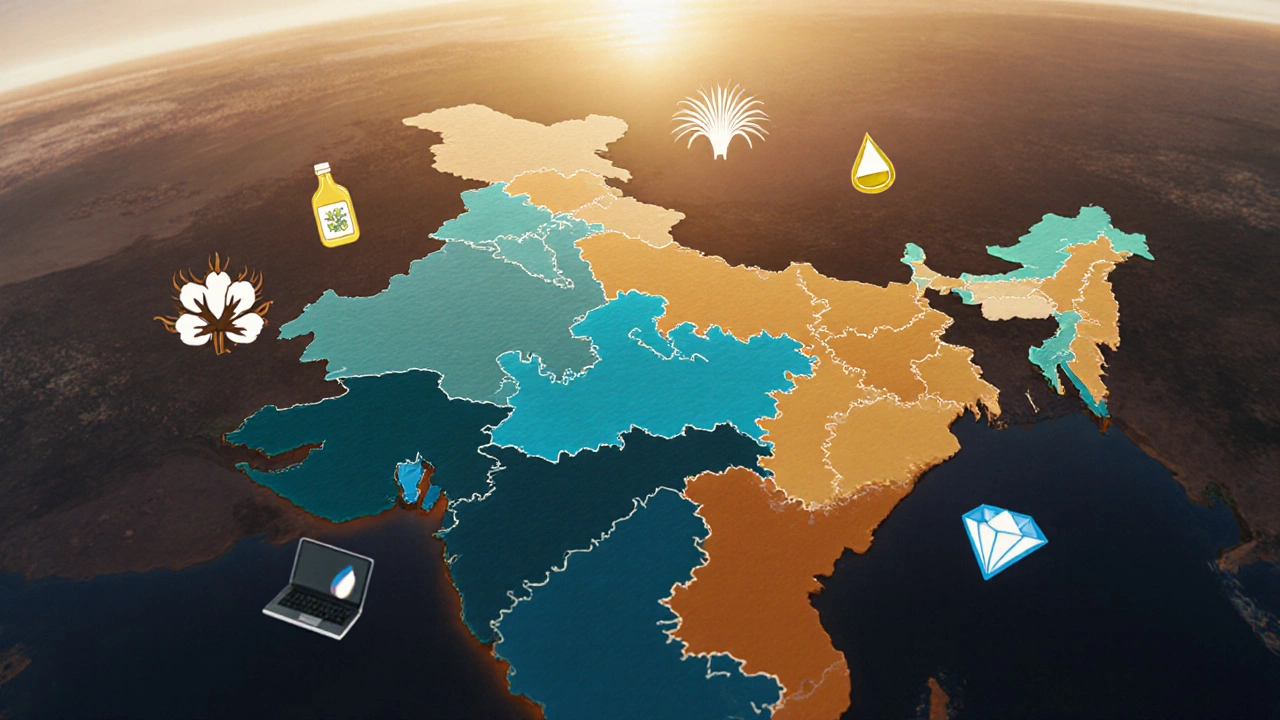India Export Sector Revenue Calculator
Ever wondered what makes India a global player in the trade arena? The answer lies in a handful of product categories and services where the country has built deep expertise, supportive policies, and a massive workforce. This guide breaks down the sectors that drive India’s trade balance, shows where regional strengths lie, and points out the training routes you can take if you want to join the game.
Key Takeaways
- Textiles, pharmaceuticals, and IT services account for more than half of India’s export value.
- States such as Gujarat, Tamil Nadu, and Maharashtra are the powerhouses for specific commodities.
- Trade policies-like the WTO commitments and recent RCEP talks-shape market access and tariff levels.
- Numerous trade courses India offer certificates in export documentation, customs clearance, and sector‑specific skills.
- New entrants should watch currency volatility, compliance hurdles, and shifting global demand.
Understanding India’s Trade Landscape
India's Trade Specializations is a blend of traditional manufacturing, high‑tech services, and natural resource processing that together form the backbone of the nation’s export economy. In fiscal year 2024‑25, the country earned roughly $450 billion from overseas sales, a figure that reflects both legacy industries and rapidly growing digital services. While the headline number is impressive, the real story lives in the specific categories that consistently outperform their global peers.
Top Export Sectors and Why They Shine
Below is a snapshot of the biggest export earners and the reasons they stay ahead of the curve.
- Textiles & Apparel - India ranks among the top three global textile exporters. Low‑cost cotton, a vast base of skilled weavers, and a push for sustainable fabrics keep buyers coming back. The sector contributed about $45 billion in FY 2024‑25.
- Pharmaceuticals - Known as the "pharmacy of the world," India supplies over 20 % of global generic medicines. Strong R&D labs, cost‑effective production, and compliance with US FDA standards drive demand.
- IT Services & Business Process Outsourcing - With a talent pool of 5 million engineers, India’s software exports topped $180 billion, covering everything from cloud migration to AI development.
- Petroleum Products - Refined fuels and petrochemicals, especially from Gujarat’s refinery clusters, generate roughly $30 billion each year, thanks to strategic port access.
- Agricultural Products - Rice, spices, tea, and mangoes enjoy a strong brand image. The sector benefits from a network of smallholder farmers and increasingly robust cold‑chain logistics.
- Gemstones & Jewelry - India’s diamond cutting and gold jewelry sectors are famed for craftsmanship. Exports exceed $10 billion, with strong ties to the US and European markets.
- Automobiles & Auto Parts - While domestic consumption is huge, exports of two‑wheelers, commercial vehicles, and components are rising, driven by competitive pricing and engineering expertise.

Regional Strengths: Where the Goods Come From
Geography matters. Certain states have built ecosystems that favour specific commodities.
- Gujarat - Dominates petroleum refining, chemicals, and gemstone processing thanks to its long coastline and industrial parks.
- Tamil Nadu - A hub for textiles, automotive parts, and high‑tech hardware, backed by a large engineering workforce.
- Maharashtra - Leads in pharmaceuticals, IT services, and chemicals, centered around Mumbai and Pune.
- Punjab & Haryana - Core grain producers; export‑ready rice and wheat pulses flow from these plains.
- Karnataka - The Silicon Valley of India, exporting software, biotech, and aerospace components.
Impact of Trade Policies and Agreements
India’s trade performance doesn’t happen in a vacuum. Government policies, multilateral agreements, and bilateral deals shape market access.
- World Trade Organization (WTO) membership ensures most‑favoured‑nation (MFN) tariff treatment for many products, reducing barriers in Europe and the US.
- Regional Comprehensive Economic Partnership (RCEP) negotiations aim to open South‑East Asian markets for Indian services and agricultural goods.
- Export Promotion Capital Goods (EPCG) scheme provides duty‑free import of capital equipment for exporters, encouraging technology upgrades.
- Recent tariff reductions on textiles with the EU have boosted fashion‑forward exports from South India.
Skill Development and Courses to Tap Into These Sectors
If you’re eyeing a career in any of the high‑earning export arenas, there are plenty of trade courses India that blend theory with hands‑on practice.
- Export Documentation & Customs Clearance - Certificate programs teach Bill of Lading preparation, HS‑code classification, and compliance with the Directorate General of Foreign Trade (DGFT).
- Supply Chain Management for Textiles - Short‑term diplomas cover sourcing, quality control, and eco‑labeling standards.
- Pharma Regulatory Affairs - Courses focus on FDA, EMA, and CDSCO guidelines, plus Good Manufacturing Practices (GMP) basics.
- IT Service Export Management - Modules include global project delivery, offshore‑onshore coordination, and cybersecurity compliance.
- Agricultural Export Marketing - Training on organic certification, phytosanitary procedures, and cold‑chain logistics.
Most of these programs are offered by state vocational institutes, private training houses, and online platforms like Coursera and NPTEL, with certificates recognized by industry bodies such as the Federation of Indian Export Organisations (FIEO).

Risks and Opportunities for New Entrants
Getting into India’s export game is rewarding, but you need to navigate a few challenges.
- Currency Fluctuations - The rupee’s swings can affect profit margins; hedging strategies are essential.
- Regulatory Compliance - Different product categories have distinct licensing requirements; missing a certificate can delay shipments.
- Infrastructure Gaps - While ports like Mundra and Nhava Sheva are world‑class, inland logistics can still be a bottleneck.
- Market Diversification - Relying on a single destination (e.g., the US) increases exposure to trade‑policy shifts.
- Digital Adoption - Companies that invest in ERP, blockchain tracking, and e‑commerce platforms gain a competitive edge.
At the same time, emerging trends-such as green energy equipment, medical devices, and AI‑driven services-open fresh niches for exporters willing to innovate.
Quick Checklist for Businesses Looking to Export to/From India
- Identify your target sector and verify its HS‑code.
- Check the latest tariff rates on the Indian Ministry of Commerce portal.
- Secure any required licences (e.g., IEC, Export Promotion Code).
- Enroll in a relevant trade certification to understand documentation.
- Partner with a local freight forwarder familiar with port clearance.
- Set up a hedging plan to protect against rupee volatility.
- Monitor policy updates-especially around GST and customs duty reforms.
Frequently Asked Questions
Which Indian export sector offers the highest growth potential in 2025?
IT services and AI‑driven solutions are expected to grow over 12 % annually, driven by demand from North America and Europe for digital transformation projects.
Do I need a special licence to export textiles from India?
Yes. You must obtain an Import‑Export Code (IEC) from DGFT and, for certain fabric types, a specific export licence under the Export Promotion Capital Goods scheme.
Where can I find reputable trade courses focused on export documentation?
Institutes such as the National Institute of Export Management, NPTEL’s online certificate, and state vocational training centers offer short‑term courses covering Bill of Lading, HS‑code classification, and customs compliance.
How does the WTO membership affect Indian exporters?
WTO membership grants most‑favoured‑nation (MFN) status, meaning Indian goods often enjoy lower tariffs in partner countries compared to non‑WTO members, facilitating smoother market entry.
Which Indian states should I target for sourcing gemstones?
Gujarat and Karnataka host the majority of cutting and polishing units, with established supply chains that cater to both wholesale and retail markets.
